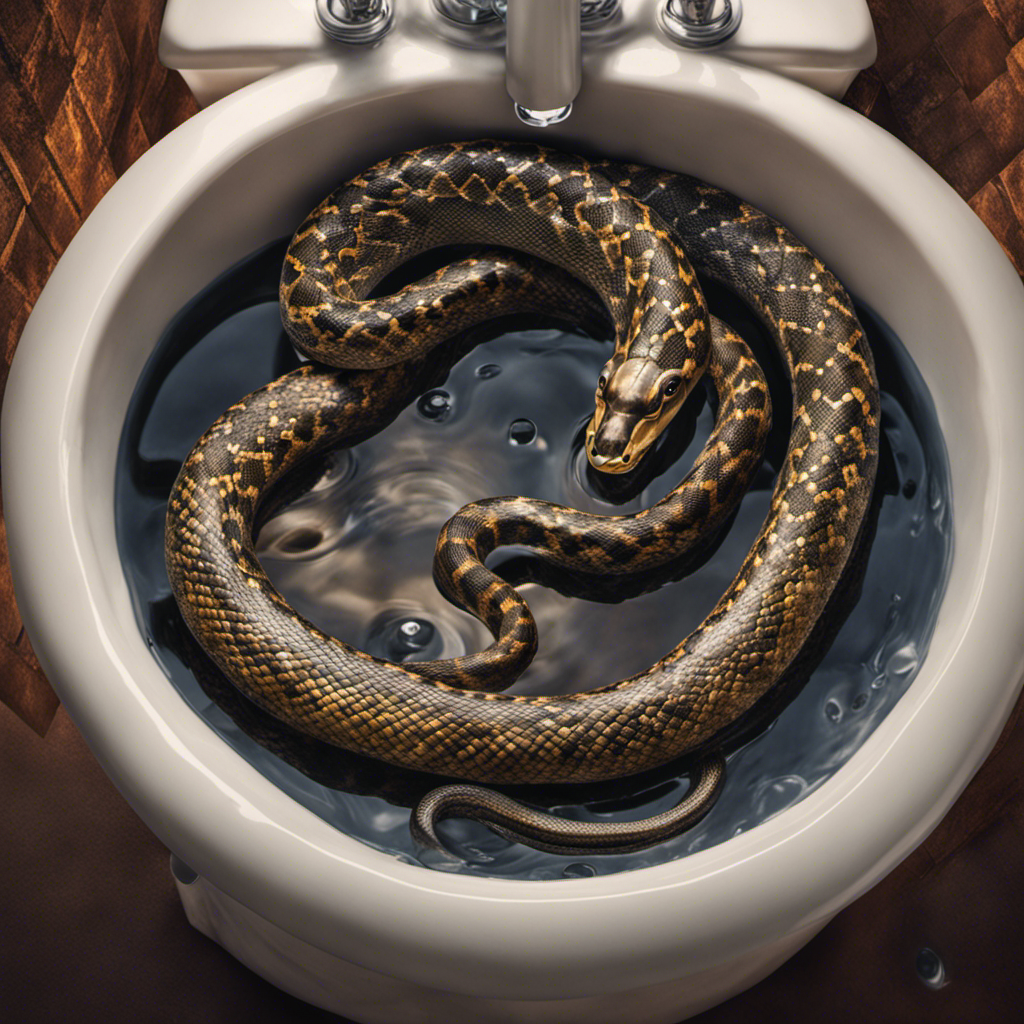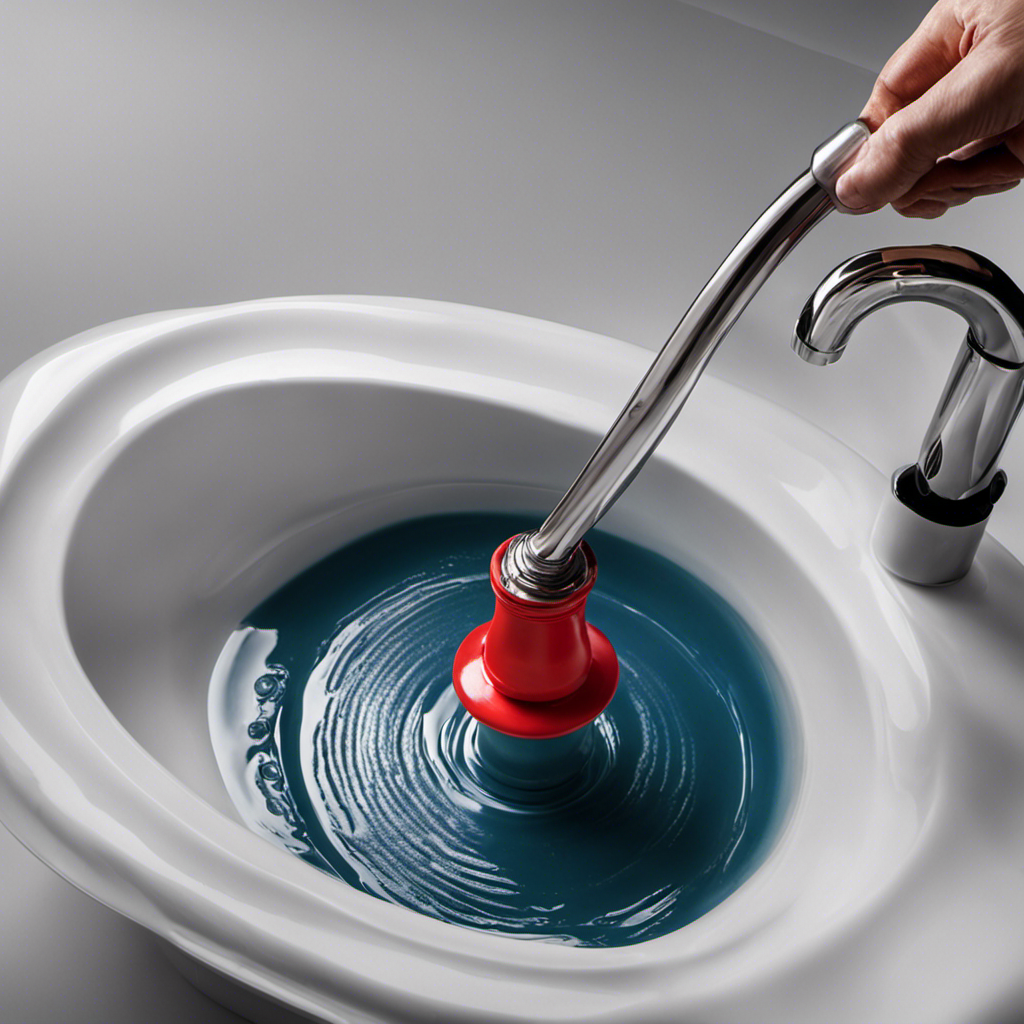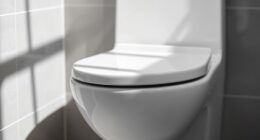If you’ve ever found yourself standing ankle-deep in water while taking a shower, it’s time to learn how to snake a bathtub.
Don’t worry, with a few simple steps, you can tackle this problem head-on.
- Gather the necessary tools.
- Clear the drain opening.
- Insert the snake into the drain.
- Rotate and push the snake through the drain.
- Retrieve the snake and clean up any debris.
- Finally, test the bathtub drain for proper drainage.
Get ready to say goodbye to those clogged drains!
Key Takeaways
- The necessary tools and materials for snaking a bathtub include a drain snake, gloves, a bucket or plastic bag, a plunger, and chemical drain cleaner.
- To clear the drain opening, remove visible debris, use a plunger, pour boiling water down the drain, and consider using a chemical drain cleaner or drain auger for stubborn clogs.
- When inserting and navigating the snake into the drain, guide it with a twisting motion, hold the handle firmly, and be aware of any resistance or obstructions.
- When rotating and pushing the snake through the drain, rotate it clockwise, push it forward steadily, avoid excessive force, and be patient. Thoroughly clean the snake afterwards.
Step 1: Gather the Necessary Tools
First, you’ll need to gather the necessary tools for snaking your bathtub. Snake maintenance is an essential part of bathtub plumbing to keep the drains clear and prevent clogs.
To start, you’ll need a drain snake, which is a flexible auger designed to break up and remove clogs. Make sure to choose a snake that is long enough to reach the clog in your bathtub.
Additionally, you’ll need a pair of gloves to protect your hands from any debris or bacteria. It’s also helpful to have a bucket or plastic bag nearby to collect any debris that you remove from the drain.
With these tools in hand, you’ll be ready to tackle any clogs in your bathtub plumbing.
Step 2: Clear the Drain Opening
Next, you’ll want to make sure the drain opening is clear. This is an important step in snake maintenance and will ensure effective drain cleaning techniques.
Here are some tips to help you clear the drain opening:
- Remove any visible debris, such as hair or soap scum, using a pair of gloves or tweezers.
- Use a plunger to create suction and dislodge any clogs near the surface.
- Pour boiling water down the drain to help break up stubborn clogs.
- If the drain is still blocked, try using a chemical drain cleaner, following the manufacturer’s instructions.
- Consider using a drain auger or plumber’s snake to reach deeper clogs.
Step 3: Insert the Snake Into the Drain
To insert the snake into the drain, carefully guide it through the drain opening using a gentle, twisting motion. Start by positioning yourself so you have a clear view of the drain opening.
Hold the handle of the snake firmly with one hand, and use your other hand to guide the snake into the drain. Slowly push the snake further into the drain, making sure it stays centered.
As you insert the snake, be mindful of any resistance or obstructions you may encounter. If you feel any resistance, stop and gently twist the snake to help it navigate through the blockage.
Continue to insert the snake until you reach the clog, and then you can begin the process of clearing the drain.
Step 4: Rotate and Push the Snake Through the Drain
Once you reach the clog, gently twist and push the snake through the drain to clear the blockage. This step requires careful maneuvering techniques to effectively clear your bathtub drain. Here are some helpful tips to follow:
-
Rotate the snake: Rotate the snake in a clockwise direction while applying gentle pressure. This helps the snake navigate through the clog and break it apart.
-
Push forward: As you rotate the snake, push it forward steadily. This will ensure the snake reaches deeper into the drain and dislodges any debris or hair causing the blockage.
-
Avoid excessive force: While it’s important to apply pressure, avoid using excessive force as it may damage the pipes.
-
Be patient: Clearing a clog may take time, especially if it’s a stubborn one. Take your time and keep repeating the rotating and pushing motion until the drain is completely clear.
-
Clean the snake: After clearing the clog, clean the snake thoroughly to remove any debris and prevent future blockages.
Step 5: Retrieve the Snake and Clean up Any Debris
Now that you’ve successfully removed the clog from your bathtub drain using a snake, it’s important to learn some techniques for snake removal, dealing with clogs, and preventing future blockages.
Snake removal techniques involve carefully pulling the snake out of the drain, making sure to clean up any debris that may have come loose during the process.
Dealing with clogs includes disposing of any waste material properly and using preventive measures, such as regular drain cleaning, to avoid future blockages.
Snake Removal Techniques
When snaking the bathtub drain, you’ll want to be careful not to push the clog further down the pipe. Here are some snake removal techniques to ensure snake safety and effectively deal with common bathtub clogs:
-
Gently twist and pull: Slowly rotate the snake while pulling it out of the drain to avoid any damage or causing the clog to get stuck.
-
Clean the snake: After removing the snake from the drain, make sure to clean it thoroughly to remove any debris or residue.
-
Inspect the drain: Take a look at the drain to see if any remaining clog or debris is visible. If so, use a plumber’s brush to remove it.
-
Flush with water: Run hot water down the drain for a few minutes to help clear out any remaining debris.
-
Preventive measures: To avoid future clogs, use drain covers to catch hair and other debris, and regularly clean out the drain stopper.
By following these snake removal techniques, you can safely and effectively deal with common bathtub clogs.
In the next section, we will discuss additional methods for dealing with stubborn clogs.
Dealing With Clogs
To effectively deal with clogs, it’s important to consider preventive measures and regularly clean out the drain stopper.
Dealing with stubborn clogs can be a hassle, but before reaching for harsh chemicals or calling a plumber, try using natural drain cleaners.
One effective option is a mixture of baking soda and vinegar. Start by pouring half a cup of baking soda down the drain, followed by half a cup of vinegar. Let it sit for about 15 minutes, then flush it with hot water.
Another natural alternative is using a combination of salt and boiling water. Simply pour half a cup of salt down the drain, followed by a pot of boiling water. This method can help break down grease and other debris. Remember to always exercise caution when working with boiling water.
Preventing Future Blockages
One way to prevent future blockages is by installing a drain strainer in your sink. This simple device catches hair and debris before it goes down the drain, reducing the risk of clogs.
In addition to using a drain strainer, there are several other maintenance tips you can follow to keep your bathtub drain clear:
- Regularly clean the drain stopper to remove any buildup.
- Avoid pouring grease or oil down the drain.
- Use a hair catcher in the shower to prevent hair from going down the drain.
- Flush your drains with hot water and baking soda once a month to remove any buildup.
- Consider using a biodegradable drain cleaner to help break down any organic matter.
By following these preventative measures, you can greatly reduce the chances of experiencing future blockages in your bathtub drain.
Now, let’s move on to the next step: testing the bathtub drain for proper drainage.
Step 6: Test the Bathtub Drain for Proper Drainage
Now that you’ve successfully cleared the bathtub drain, it’s important to assess the water flow to ensure everything is working properly.
Start by observing the water flow as you let it run for a few minutes. If you notice any slow draining or standing water, it’s time to move on to clog identification techniques.
By using simple tools like a plunger or drain snake, you can easily identify and remove any remaining clogs.
If the issue persists, don’t worry – proper drainage troubleshooting techniques will help you pinpoint and resolve the problem.
Water Flow Assessment
Assess how well the water is flowing in your bathtub using a simple test. To conduct a water pressure analysis and identify common drainage issues, follow these steps:
- Fill the bathtub with water to the desired level.
- Place a small object, such as a rubber duck or a floating toy, in the drain.
- Start the water flow and observe how quickly the water drains.
If the water drains slowly or doesn’t drain at all, it indicates a potential blockage in the pipes. If the water drains too quickly, it may be a sign of a larger plumbing problem, such as a clog in the main sewer line.
Clog Identification Techniques
To identify potential clogs in your drainage system, try using a plunger or pouring a mixture of hot water and vinegar down the drain. These simple techniques can help you prevent major clogs and save you from costly repairs.
Start by using a plunger to create suction and dislodge any blockages. Place the plunger over the drain and push down firmly, then pull up quickly to create a vacuum effect. Repeat this motion a few times to help clear any debris.
If the plunger doesn’t work, try pouring a mixture of hot water and vinegar down the drain. The hot water will help dissolve any greasy buildup, while the vinegar will break down mineral deposits. Let it sit for a few minutes, then flush with hot water.
Regularly using these DIY drain cleaning techniques can help keep your drains clear and prevent clogs from forming.
Proper Drainage Troubleshooting
If the plunger and vinegar mixture don’t resolve the issue, you may need to call a professional to assess the problem with your drainage system. Before doing so, there are a few troubleshooting steps you can take to determine the cause of your bathtub drainage issues:
-
Check the water pressure: Low water pressure can be a common cause of slow drainage. Make sure the water pressure in your bathtub is at an adequate level.
-
Inspect the drain stopper: Sometimes, a buildup of hair and debris can cause the drain stopper to clog. Remove the stopper and clean it thoroughly.
-
Use a drain snake: A drain snake is a handy tool that can help you remove any blockages deep within your pipes.
-
Clear the overflow drain: The overflow drain can also get clogged with dirt and grime. Clean it using a wire brush or a pipe cleaner.
-
Check the vent system: A blocked vent pipe can negatively affect the drainage of your bathtub. Inspect the vent system and remove any obstructions.
Frequently Asked Questions
How Long Does It Usually Take to Snake a Bathtub Drain?
It usually takes about 30 minutes to snake a bathtub drain. To unclog a bathtub drain without a snake, try using a plunger or a mixture of baking soda and vinegar. Prevent clogs by using a drain cover and avoiding pouring grease or hair down the drain.
Can I Use a Regular Plunger Instead of a Snake to Unclog My Bathtub Drain?
You can try using a regular plunger to unclog your bathtub drain, but it may not be as effective as a snake. The pros are that it’s a simple and inexpensive method, but the cons are that it may not always work for tougher clogs.
What Should I Do if the Snake Gets Stuck in the Drain?
If the snake gets stuck in the drain, don’t panic. Turn off the power to the snake and try gently pulling it back. If that doesn’t work, you can try alternative methods, but be cautious of potential risks.
Is It Necessary to Wear Gloves While Snaking a Bathtub Drain?
When snaking a bathtub drain, it is important to prioritize your safety. Wearing gloves is necessary to protect your hands from any potential hazards and maintain proper hygiene during the process.
Can I Use a Chemical Drain Cleaner Before Snaking the Bathtub Drain?
Yes, you can use a chemical drain cleaner before snaking your bathtub drain. However, it’s important to consider the pros and cons. Chemicals may temporarily unclog the drain, but they can also damage pipes and be harmful to your health.
Conclusion
Congratulations! You’ve successfully learned how to snake a bathtub drain and become the ultimate hero of unclogging! Armed with your trusty tools and a little bit of determination, you fearlessly tackled the clogged mess in your bathroom.
With each rotation of the snake, you conquered the stubborn blockage and triumphantly retrieved it from the depths of the drain. Now, your bathtub drains like a champion, leaving you feeling accomplished and ready to take on any plumbing challenge that comes your way.
Keep up the great work, and may your drains forever be clear and flowing smoothly!










